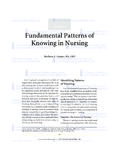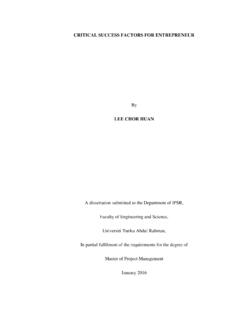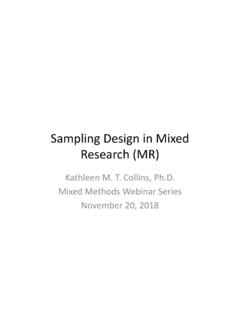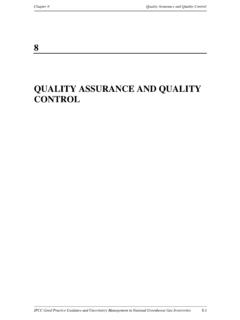Transcription of Analyzing Case Study Evidence
1 1275 AnalyzingCaseStudyEvidenceHowto Star t You r Analysis, YourAnalyticChoi ces, and How TheyWorkAN ANALYTIC STRATEGY: MORETHANFAMILIARITYWITHANALYTICTOOLSN eedfor an AnalyticStrate analysisof case Study evidenceis one of the least dev elopedand most diff ic ult aspectsof doi ng case many times, inve stigatorsstart case studieswithouthavingthe foggiestnotion about how the evidenceis to be analyzed(de spite Chapter3 s rec ommendationtha t the analyticapproaches be considered when dev elopingthe ca se Study protocol).Suchinvestigations eas ily becomestalledat the analyticstage; this author hasknowncolleagueswho have simplyignoredtheir case Study data for monthafter month, not knowingwhat to do with the the problem,the expe riencedca se Study inves tig ator is likely toha ve grea t adv antagesove r the no vice at the ana lytic stage. Unlikestatisticalanalysis,ther e are few fi xed formulasor cookbookrecipesto guide the ,muc h dependson an inves tigator sow n style of rigorousempiricalthinking,along with the suffi ci ent presentationof Evidence and ca re ful con -sideration of alternativeinter vest ig ators and espe cially novicesdo continueto searchfor formulas,recipes,or tools, hopingthat familia rit y with the se deviceswill producetheneededanalyticresu lt.
2 The tools are impor ta nt and can be use ful, but they areusuallymos t helpfulif you know what to look for ( , hav e an ov erall ana -lytic stra tegy), whi ch unfortunatelyreturnsyou back to your origina l problem,if you hadn t noti te d in st ance, computer-assistedrout in es with prepack-ag ed software suc h as Atl as. ti, Hype rRESEARCH, NVivo,or Th e Ethnog raphall are examplesofcomputer-assistedqualitativeda taanaly sissoftwa re(CA QDAS , Fie lding& Lee,1998 ). The softwa re has becomemorediverseand func tional over the pas tdeca de. Esse ntially,the tools can helpyou code and categorizelarge amountsofnarrati ve text, asmight hav ebeen col -lecte d from ope n-endedinterviewsorfrom large volumesof writtenmaterials,such as newsp aper ar tic le s. Guidanceoncoding skills and techniquesalso hasimproved( , Boyatzis,1998).Key to your understandingof thevalue of these packa ges are two wor softwarewillnot do any analysisfor you, but it mayser ve as an abl e assistantand reliabletool.
3 For instance,if you enter yourtextual dat a and then define an initialset of codes, one or anot her of the var -ious softwarepacka ges will readilylocate in the textualdata all words andphrasesmatchingthe se code s, count the incidence or occur re nce of the wordsor co des, and even conductBoolea n searches to sho w whe n and where multi -pl e com binat ions are found ca n do this proces s iteratively,grad -ually buildingmore complexcategoriesor groupsof codes. Ho wev er, unlik estatistical ana lyses, you cannot use the softwa re s outputsthemse lv es as if theywere the end of your d, you wil l need to Study the outputsto determinewhetherany mean -ingful pat terns are likel y, any pa tte rns suchas the fre quencyof codes or code combinations willstill be conce ptuallymore primitive(lower)than the ini tial ho w and why res earch questionsthat might haveled to your case Study in the first place.
4 In other words , dev elopinga rich andfull explanationor even a good descri ption of your cas e, in res ponse to yourinitial how or w hy questions,will requiremuch post-computer thinkingand analysison your pa kt racking, you also will need to have clari fi ed the reason s for defin ing theinit ia l code s or subsequent code s, as wel l as connecting th em to you r orig inalre se arch design (y ou, not the software, createdthem) .Inwhat way sdo the codesor conceptsac cu ra tely re fle ct th e me aning of the retri eved words and phrases,an d why? Answ ering th ese questi ons requir es your own analy ti c rat :HowdoIstartanalyzingmycasestudydata?You mightstart wi thquestions( , the quest io nsin yo ur case studypro tocol )rather than with the da ta. St art with asmall question fi rst, then ide ntify yo urevidencethat addr esses the que a tent ative co nclus ion based onthe weightof the evide nce, al so ask inghow you shou ld displaythe evide nceso that readerscan chec k ntinueto a larg erquestionand repeatthe pr oc goin g until you think you haveaddressed you r main researchquestion(s).
5 Could you have star ted with thedata insteadof the questions ?ANALYZINGCASESTUDYEVIDENCE129 Under some ci rcum sta nces, the comput erize d func tions can nevertheless beext remelyhel pful. The minimalconditionsinc lude when (a) the words or verba lreportsrepresentverba tim records and are the central pa rt of your cas e Study evi -den ce and (b) you have a la rge colle ct ion of such data . Such conditionscom -monl yoccur in researc husinggroundedtheorystrategies( , Cor bin &Stra uss,2007), where the surf aci ng of a new conceptor theme ca n be highly va er, even under the be st of circum st ances ,nearly all schola rs expressstrongcaveatsabout any use of computer-assistedtools: You must still be preparedto bethe main analystand to direc t the tool s; they are the assis ta nt, not case studiespos e a mor e seriousch alle nge in efforts to us e computer-assi sted tools: Verbatimrecordssuch as inte rviewe es re sponse s are likely tobe only part of the tota l array of case Study Evidence .
6 The case Study will typ -ically be about co mp lex events and behavior,oc curringwithin a pos sibly morecompl ex, rea l- life con vert all of your Evidence includingyour fie ld note s and the archivaldoc umentsyou might hav e colle cted intothe ne eded te xtual form, computerized tools cannot re adily ha ndle this morediversearray of evide nce . Yet, as emphasizedin Chapter4, such an arrayshouldre pr esent an importantstre ngth of your cas e Study . For a diversese t ofevidence,you thereforeneed to developyour ow n analyticstra te helpfulstarti ng point is to play with your data. One se t of analyticmanipulations has be en comprehensively de sc ribed and summarized by Milesand Hube rma n (1994)and includes Puttinginformation into diff er ent arr ays Makinga matrix of cate gories and placingthe evidencewithin such categories Cre ating dat a displays flowcharts and other graphics forexaminingthe data Tabulat ing the frequencyof dif ferent events Exam ining the complexityof such tabulationsand thei r relationshipsby calculat-ing second-ordernumberssuch as means and var iances Puttinginformation in chronologicalorder or using some other temporalschemeThe se are inde ed useful and im portantmani pulationsand ca nput the evidencein some prelimi nary order.
7 Mo reover, conductingsuch manipulatio ns is one wayof overcomingth e stall in g prob lem mentionedearl ier. Wit ho ut a broaderst rat -egy, however, you are still likely to en count er many false star ts and po tent ial lywa ste large ch un ks of your time. Furt hermore,if after playi ng wi th th e dat a, age neral strat eg ydo es not emerge(or if you are not facile in pl aying wit hth edatato be gin with), the entir e case st udy ana lysis is likely to be in preliminary manipulations,suc h as the prec eding, or an y use of com -puter-assisted tools there fore ca nnot su bstitutefor havinga gener al analytic130 CASESTUDYRESEARCH strategyin the first place. Put anotherway, all empiricalrese arc h studies,includingcase studies,have a story to te ll. The story differ s from a fictionalaccou nt becauseit embraces your data, but it re mains a story be caus e it mustha ve a be ginning,end, and middle.
8 The neede d analyticstra tegy is your guideto craftingthis story, and only ra rely wi ll your da ta do the craftingfor you have a st rategy,the tools ma y turn out to be extremelyus eful (orirrelev ant). The str ategy will he lp you to trea t the evidencefairly, produc ecompe lling analyt ic conc lus ions, and rule out alte rna tiv e o will he lp you to use tools and mak e manipulationsmore effec -tively and efficiently. Four such strategiesare describedbelow, afte rwhich fivespecifictechniquesfor analyzingcase Study data are e strate -gi es or techniquesare not mutuallyexclu sive .You can use any numberof themin any continuedalert is to be aw are of thes e choicesbeforecollecting your dat a, so tha t you can be sure your data will be r GeneralStrategiesRelyingon the oret ical first and mos t pre fe rred stra tegy is tofollowthe theoretical propositions that led to your case Study .
9 The originalobjectives and des ign of the cas e Study presumably were based on such propo -sitions,which in turn re flecteda set of resea rch ques tions , re views of the lit -eratur e, and new hypotheses or propositio ns would have sha ped your data collectionplan and thereforewould have given pr ioritie s to the rele vant analyticstrate gie s. One exa mple ,from a st udy of inter governmentalrelationships,follo wed the propositiontha tfederalfunds have redistributivedollar effec ts but also create ne w org aniza -tional change s at the local le vel (Yin , 1980).The bas ic proposition thecreationof a counterpartburea ucracy in the form of loc al pla nning or gani -zations, citi zen action groups,and othe r new officeswithin a local go vernmentitself , but all attunedto spec if ic fede ral programs wastrace d in cas e studie sof severa l cities.
10 For each city , the purposeof the cas e Study was to show ho wthe formationand modif ic ation in local organizations oc curredafterchangesin relat ed federalpro grams and how thes e loc al orga niz ations acted on be halfof the federalprogramseve nthoughthey might have be en componentsof pro posit ion is an exampleof a theoretical orienta tion guidin g th e cas est udy ,the pro positionhel ps to focus at tentio n on certaindataand to igno re oth er data. (A goo d tes t is to decide what data you mi gh t cit e ifyou had onl y 5 min utes to defenda pr oposit ion in yo ur case st udy.) The propo -sit ion also help s to organizethe entire case st udy and to define al terna tiv eANALYZINGCASESTUDYEVIDENCE131expl anationsto be ex prop osition s st emmingfrom how an d why questionscan be extremelyuse ful in guid ing cas e Study an alys isin th is ca se seco nd generalanal yt ic strategyis to developa de scr iptive frameworkfor organizing the case st udy.














